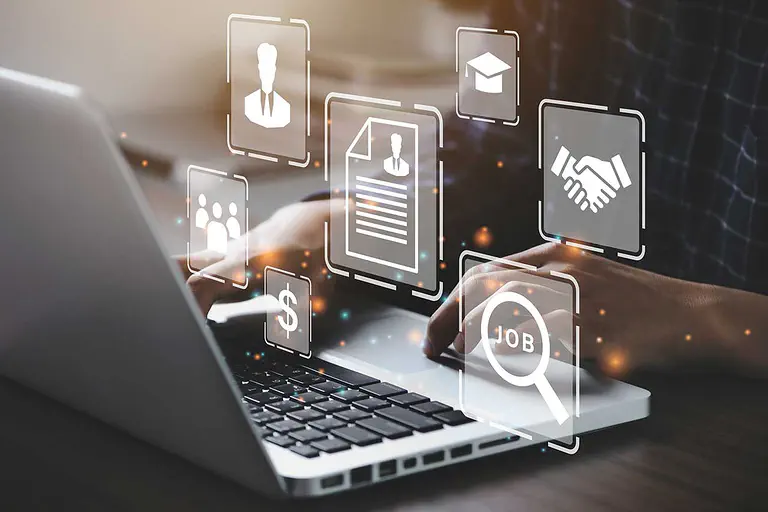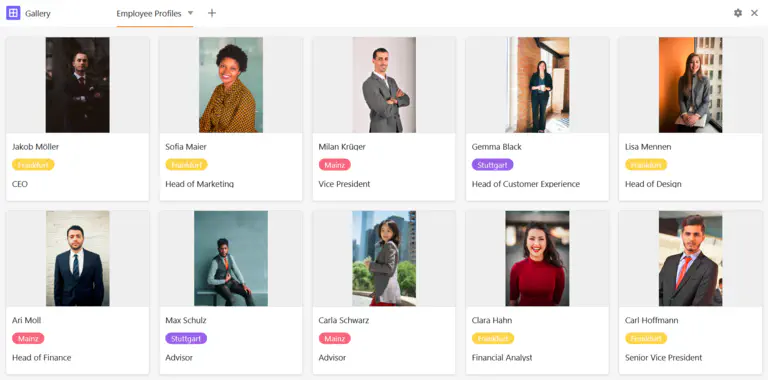What is an HRIS? #
A Human Resources Information System (HRIS) is a software solution that allows you to record, store and manage your company’s employee data. In any case, an HRIS must cover the basic functions and processes required for smooth HR administration. These include, among other things:
- Management of employee data and personnel files
- Staff scheduling and time recording
- Vacation requests and sick leave
- Payroll / payroll accounting
- Social insurance and benefits
- Reports and analyses

What distinguishes an HRIS from an HRMS? #
As HR management software is often a classic all-in-one solution, the differences between an HR management system and an HRIS are not immediately obvious. The terms are therefore often mistakenly used interchangeably. However, an HRIS only refers to the administration of existing employees and basic processes that are essential for a functioning operation.
A Human Resources Management System (HRMS) goes much further in this respect. Put simply, an HR management system comprises all the functions of an HRIS and more:
- Recruiting and applicant management
- Onboarding and offboarding
- Employee retention and satisfaction
Human Capital Management (HCM) is also sometimes mentioned. In addition to the HR management / information system, this includes other processes at a strategic level, such as
- Talent management and career paths
- Compensation management
- Personnel development and training

The range of functions of HR management software varies considerably depending on the provider. So when choosing your HR management software, pay attention to which functions you need. While an HRIS convinces with a simple employee database for everyday administrative processes, an HRMS offers more complex functions for (qualitative) personnel planning.
Why an HRIS is indispensable #
Essentially, an HRIS offers you the opportunity to make processes in your HR department more efficient and to make data-based decisions. After all, the HR department is one of the most administration-intensive departments in any company, alongside accounting. Therefore, not only are you faced with an enormous amount of bureaucracy and paperwork, but you also manage particularly valuable and sensitive information about your employees and applicants.
An HRIS usually gives employees access to certain digital systems for working time recording, vacation planning and sick leave. This means that they can enter their data and upload documents themselves, thus relieving the HR department. You can also use this HR database to provide your employees with payslips, forms for certain applications, information material and checklists for specific processes such as onboarding and offboarding as part of employee self-service.
A modern HR information system can also automate workflows, integrate feedback and aggregate data for reporting. Thanks to real-time synchronization, intuitive user interfaces and flexible functions, modern HRIS make it possible to work extremely efficiently, productively and agilely.
How data protection succeeds with an HRIS #
As an HRIS contains sensitive, personal information, there are high requirements for security and access control. Data is usually stored in a central HR database. Who can access which data records is usually defined on the basis of roles or individual access rights.
What is an HR database? #
An HR or personnel database is an IT system for storing, aggregating and analyzing employee data.
The following points must be ensured:
- Compliance with all data protection regulations (e.g. GDPR)
- Confidentiality of personnel data and protection against unauthorized access
- Reliable data backup and protection against data loss
- Authentication of the user
- Integrity of data and protection against falsification
- Traceability of data entry and change history
- Timely deletion of expired data
In the past, HRIS software was almost always used on-premises , which means that it ran on the company’s own technical infrastructure. Nowadays, HR management software is often located in the cloud . This has the great advantage that you and your employees can access all data at any time and from anywhere.

The most important advantages of an HRIS at a glance #
An HR information system has advantages that go far beyond the possibilities of an Excel employee database. These essentially include
Central access and up-to-dateness
Minimal effort through automation
Lower costs
Perfect overview
High level of self-determination and transparency
SeaTable as HRIS or HRMS #
SeaTable is a no-code database that is ideal as HR management software for the cloud or on-premises. SeaTable offers maximum flexibility and scalability - you decide how you want to map your processes in the software and which functions you require.
For example, you can start with an employee directory template , which represents an HR database in its simplest form.

This is an internal employee directory with information that is visible to everyone in the company. You could use such an employee list for profiles in the HR information system or to create business cards, for example.
You can then expand your HR database with additional tables and functions as you wish. How about an interactive working time account , for example, to record all attendances, vacations and illnesses? Or with digital personnel files in which all certificates, CVs and payslips can be accessed?
In addition to the functions of an HRIS, you can also use SeaTable to implement recruiting, applicant management and onboarding. Even personnel development and training can be organized in SeaTable. As a German HR database, SeaTable meets the highest data protection standards (GDPR) and stores all data securely in German data centers. So it’s hard to believe that this fully-fledged HR management software is free.
Register today and discover our free templates for HR managers!
TAGS: HR Administration
